Introducing my son to gaming
I've been trying to encourage the next generation of wargamers (i.e. my son, Tom) to get involved before he gets too old and discovers beer and girls. I reckon I have a few years before he becomes too much like 'Kevin the teenager'. We played a game of Iron Cross from Great Escape Games this weekend on my winter table. Iron Cross is a fast play set of WWII skirmish rules.I meant to take more photos and do a proper AAR, but got side-tracked teaching him the rules and also trying to explain the reasoning behind some of the tactical decisions that I was making, so that he could learn a little about tactics.
We started on opposing tables edges and played a simple "Meeting Engagement" scenario. The table was set up with a small hamlet set off to one side, a few other randomly positioned buildings, a railway track running across the centre of the table, complete with an armoured train parked up in the sidings, and lots of trees and hedges to break up line-of-sight.
Tom played as the British with 3 Shermans, 3 units of infantry and an HQ unit. I played as the Germans using the same number of infantry, but only 2 Panthers, which balances out in terms of points value.
Despite my tactical advice, Tom pushed his Shermans forward quickly with limited infantry support. It turned out to be good decision and (maybe aided by some good dice rolls) quickly picked off one of my Panthers, which was lurking behind one of the ruined buildings.
Spurred on by his early success (only the second turn!), he continued to press forward. My dice rolling didn't help, though I did manage to destroy one of his Shermans fairly quickly, which caused him to slow his advance. By this time, both of us had brought our infantry further to the front line and started pouring fire onto each other.
The infantry battle, supported by the tanks, for the centre ground lasted for a few turns before my infantry started to accumulate too many morale points, which forced me to start spending command tokens on some Company Morale Tests. Here is my remaining Panther with the HQ squad just to the right. Tom's forces are just out of shot at the top of the photo using the cover of several buildings.
The final shot above is one of my infantry units advancing to the railway line about halfway through the game. To help Tom focus on learning the rules, we only played with three models per unit to keep the movement simple.



















































